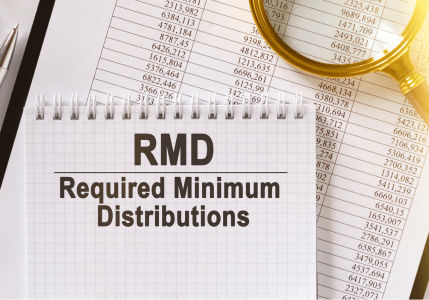Retirement Accounts & RMDs

RMDs are crucial for retirement account owners age 73 and older
Some qualified retirement account owners are surprised that the IRS requires them to take a certain amount from their accounts each year. Including required minimum distributions in your financial plan can help you avoid higher taxes and potential IRS penalties.
If you own a qualified retirement account and you’re approaching or recently reached age 73, heads up: The IRS says you must start taking annual distributions from your account. Known as required minimum distributions, or RMDs, these withdrawals begin in the year you turn 73.
Why does this rule exist? Qualified retirement accounts are funded with pre-tax money, and the account’s growth is tax-deferred. You don’t pay any taxes until you start taking withdrawals from the account. The IRS uses RMDs to limit how long you can postpone paying taxes on those funds.
How RMDs Work
The RMD rule applies to traditional IRAs, SEP or SIMPLE IRAs, and employer-sponsored plans, such as 401(k)s, 403(b)s and 457(b)s. It also pertains to profit-sharing plans and other defined contribution plans. RMDs do not apply to Roth IRAs since they are funded with post-tax money.
RMDs apply to these account types:
- Traditional IRA
- SEP IRA
- SIMPLE IRA
- 401(k)
- 403(b)
- 457(b)
- Profit-sharing plan
- Other defined contribution plan
Your total amount of RMDs will vary from year to year. The amount is calculated by taking the account balance at the end of the immediately preceding calendar year and dividing that amount by a distribution period from the “Uniform Lifetime Table” provided by the IRS.
Since withdrawals from a qualified retirement account are taxable, 100% of your RMDs are added to your taxable income for the year in which they’re taken out.
Many people own more than one qualified retirement account, and RMDs are calculated separately for each account. However, if you own more than one traditional IRA, you can take the total amount of your RMDs only from one IRA.
For example, say you own three traditional IRAs, and you’re required to take annual RMDs totaling $4,000: $500 from IRA No. 1, $1,500 from IRA No. 2 and $2,000 from IRA No. 3. You can take the whole amount from the account of your choosing or split it among two or more accounts.
If you own other retirement accounts (such as a 401(k) or 403(b)), then you must take those RMDs separately from those accounts.
Want to see how much your RMDs will be? The IRS provides a worksheet to calculate RMDs at https://www.irs.gov/retirement-plans/plan-participant-employee/required-minimum-distribution-worksheets
Donating Your RMDs
Since RMDs are taxable, many account owners prefer to donate their RMDs. Through a qualified charitable donation (QCD), the account owner can direct the RMD to be sent directly to a charitable organization. This approach is a win-win: The charity can use the funds to support its mission, while the account owner can take a tax deduction for the donation (if they itemize deductions).
Mark Your Calendar
The timing for your first RMD gets a little complicated. The IRS says you have until April 1 of the year after you turn age 73 to take your first withdrawal. So if you turned 73 on Sept. 1, 2023, you have until April 1, 2024, to request your initial RMD.
Your second and subsequent RMDs must be taken by Dec. 31 to fulfill the requirement. And don’t be late: If you miss the deadline or don’t take the RMDs at all, you could end up paying as much as 25% of the RMD as a penalty.
If you wait until April 1 of the following year to take your RMDs, you’ll be required to take two years’ worth of RMDs in one year (one for the prior year when you turned 73 and one for the current calendar year when you turned 74). Taking two sets of RMDs in one year could make a big difference in your total tax bill for that year.
If you’ve already taken previous distributions from a qualified account in the calendar year, those withdrawals count toward your RMDs. For example, if your total RMD for the year is $10,000 and you’ve already taken $5,000, you need to take an additional $5,000 to meet your annual RMD.
It’s a good practice to start the RMD process now since it can take time for custodians to process the request.
If you turned (or will turn) 72 this year, we recommend scheduling a meeting with your financial advisor soon to review your RMDs and begin the process. And whether it’s your first year or 20th year of receiving RMDs, it’s also a good idea to set up recurring, systematic distributions to fulfill your RMDs. These distributions can be made monthly, quarterly or annually and sent to you by check or direct deposit. You can also request taxes be withheld from the distributions before they are sent. Not only does this make the process convenient and easy, but it reduces the chances of missing the deadline and potentially ending up with a large penalty from the IRS.
Sources
IRS. April 20, 2023. “Retirement Topics – Required Minimum Distributions (RMDs).” https://www.irs.gov/retirement-plans/plan-participant-employee/retirement-topics-required-minimum-distributions-rmds. Accessed Nov. 30, 2023.
IRS. March 14, 2023. “Retirement Plan and IRA Required Minimum Distributions FAQs.” https://www.irs.gov/retirement-plans/retirement-plan-and-ira-required-minimum-distributions-faqs. Accessed Nov. 30, 2023.

Learn more about your current financial status and how you can achieve your retirement goals with our ‘No Obligation, No Cost’ Five Step Retirement Review.
Our financial planners have wide knowledge in South Carolina Retirement System as well as experience in retirement planning. sc tax rebate, etc. Contact us today!
Ready to Take The Next Step?
For more information about any of the products and services listed here, schedule a meeting today or register to attend a seminar.